|
|

|
Porsche, and the Porsche crest are registered trademarks of Dr. Ing. h.c. F. Porsche AG.
This site is not affiliated with Porsche in any way. Its only purpose is to provide an online forum for car enthusiasts. All other trademarks are property of their respective owners. |
|
|
  |
| jk76.914 |
 Jan 30 2010, 11:57 AM Jan 30 2010, 11:57 AM
Post
#1
|
|
Senior Member    Group: Members Posts: 809 Joined: 12-April 05 From: Massachusetts Member No.: 3,925 Region Association: North East States |
I collected a number of MPS over a couple of years. Most held vacuum, some did not. I measured inductance vs. vacuum on those that I could, but then took all of them apart (except one brand new one).
The is a lot of variety in the diaphrams, probably because they get replaced when virtually every MPS is rebuilt. The photo below shows four diaphrams. I'll follow with descriptions and observations... 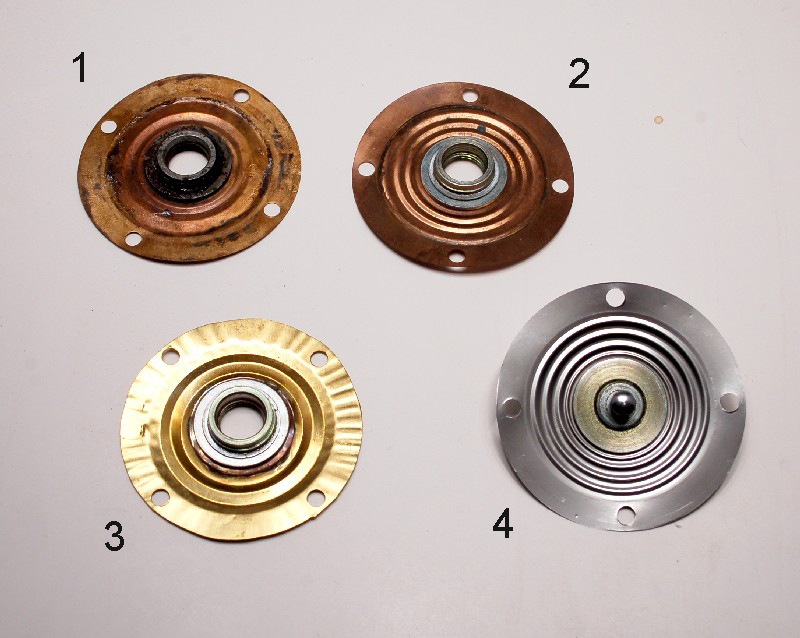 #1- copper, 2 pleats. This came from a rebuilt MPS that was in a pond or river for some time. There was actually sand in it, along with tiny aquatic snail shells of some sort, and the copper was pretty much green. This diaphram was ruptured. The workmanship is very good, and the alloy is idential to stock (see chart below). The threaded bushing looks like stock in design and attachment. #2- copper, 3 pleats. This is a stock diaphram from a riveted MPS. It is ruptured. #3- brass, 2 pleats. This is from a rebuilt MPS. I have three of these diaphrams, all similar. This MPS was freshly rebuilt in a rebuilder's box. Looked like new with fresh paint and plastic cap on vacuum port, but it leaked slightly. You can see why when you look at the ripples in that flange. The O.D. looks like it was cut out by hand with tin snips, and the threaded bushing was taken from a stock diaphram and soldered by hand into place. At the bottom in the picture, you can see that the flange is pretty smooth- that's where I tapped it out with a machinist's hammer on an anvil. I have no doubt that the leakage was from around the O.D. of the diaphram, and that tapping it out would probably fix it. This material (brass, see chart below) is stiffer and thicker than any of the rest. It would add quite a bit of spring tension to the mass-spring-damper system. In general, I rate the workmanship on this as "crappy", though maybe you could get a running car out of it. #4- stainless steel, 3 pleats. This one is a bit of an enigma. It is identical to stock except that it is made from stainless (see chart below). The workmanship is perfect. It is from a rebuilt MPS. Interestingly, it is the MOST COMPLIANT of all of them, while most steel ones are reported to be stiffer. The other part of the enigma- the aneroid cells from this MPS are also stainless- same alloy. My suspicion is that this is a late Bosch rebuilt. Who else would make stainless cells, because the cells don't fail very often, so there are lots of spares available out there, and the cells are pretty complicated to make... *** EDITED *** Materials. I measured alloy composition at work using an X-Ray Fluorescence analyzer. This machine is very precise, but it has limits to the range of elements that it can detect. Unfortunately, it cannot detect Beryllium (Be), and it is likely that the stock (at least) diaphram contains Be to harden and strengthen it. You can see a couple of things here though- the stainless diaphram and stainless cells are of exactly the same composition- nickel-chromium stainless steel. The nickel explains why they are slightly magnetic, as many stainless alloys are not. *** 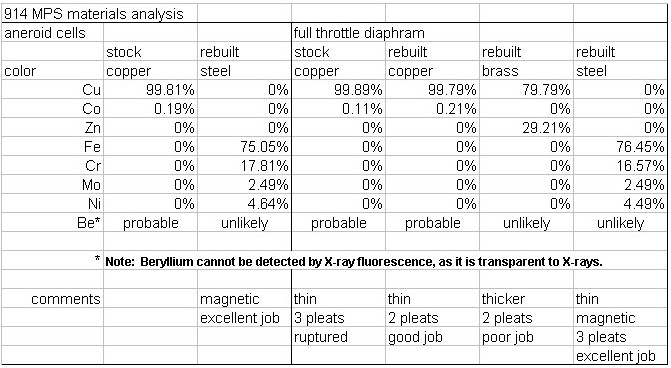 Conclusions (really opinions) - The diaphram was put in there (early VW D-jets did not have one) to provide altitude compensation and to soften transition from leaner (high vacuum) to richer (low vacuum) regions. Early D-Jets had a separate unit with a diaphram and a switch to inform the ECU to richen the mixture at low vacuum. Cost reduction may have been a third reason- eliminating the separate unit, wiring, vacuum hose, etc. Anyway, this switch was either on or off, no soft transition. The MPS had only 2 aneroid cells and no diaphram, and its inductance curve was essentially a straight line from 0" to 25". There was no mixture compensation for altitude with this arrangement. I'm thinking that the lower the stiffness of the diaphram, the more consistency in the setup and responsiveness, while both of these objectives are met. By maximizing compliance of the diaphram, the springs acting in the system are mainly the coil spring and the leaf springs that act to locate the armature. My stainless diaphram is the most compliant, but there is another feature of steel (if I remember correctly) that adds to the argument that this is a late Bosch design- steel has a much higher Youngs modulus than copper. The higher the Youngs modulus, the greater the fatigue resistance, and the vastly most common failure mode of the MPS is fatigue failure. Could this have been a Bosch attempt to solve a reliability problem, even as the technology was being superceded by more modern ones? Since the cells are also subject to fatigue, would they have switched them over at the same time? I am planning on assembling my own personal MPS using the stainless parts, and seeing how close I can tune it to my engine. There are lots of other parts in the MPS that I've formed opinions about, but I'll hold off for now. These are my own opinions, which may not be popular, so BLAST AWAY!! (eye candy below) 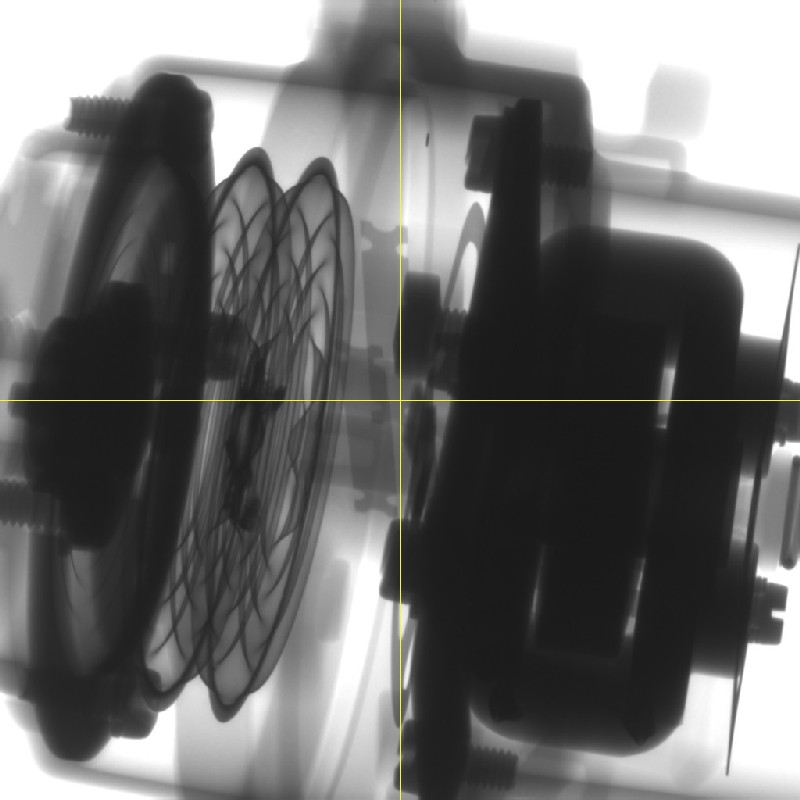 |
| Bartlett 914 |
 Jan 30 2010, 12:32 PM Jan 30 2010, 12:32 PM
Post
#2
|
|
Advanced Member     Group: Members Posts: 2,215 Joined: 30-August 05 From: South Elgin IL Member No.: 4,707 Region Association: Upper MidWest |
Great Job! That is interesting information. If it can be shown than SS will work then maybe this will resolve the availability crisis concerning these MPS units.
|
| underthetire |
 Jan 30 2010, 01:20 PM Jan 30 2010, 01:20 PM
Post
#3
|
|
914 Guru      Group: Members Posts: 5,062 Joined: 7-October 08 From: Brentwood Member No.: 9,623 Region Association: Northern California |
Good work! It was always assumed it was BeCu, and it is still available, but expensive. Stainless would solve the cost issue for sure. I had sent a MPS to a freind of mine that does stamping, and for the small qty's the price was going to be over 100 bucks each. Everyone but capn balked at the price, but the dies are not free to build.
I just think it's awesome you can check materials that way. It's very cool. |
| jk76.914 |
 Jan 30 2010, 04:14 PM Jan 30 2010, 04:14 PM
Post
#4
|
|
Senior Member    Group: Members Posts: 809 Joined: 12-April 05 From: Massachusetts Member No.: 3,925 Region Association: North East States |
Good work! It was always assumed it was BeCu, and it is still available, but expensive. Stainless would solve the cost issue for sure. I had sent a MPS to a freind of mine that does stamping, and for the small qty's the price was going to be over 100 bucks each. Everyone but capn balked at the price, but the dies are not free to build. I just think it's awesome you can check materials that way. It's very cool. The stainless story is still just a theory- I haven't proven it works as well as, much less better than, the stock. (But I think it will!) In the meantime, if you're looking to repro them, the pure copper may be a good bet. It should form better than the stainless, and it'll be a lot cheaper than BeCu alloy. Photo below is my stainless diaphram with its mating stainless cell assembly- 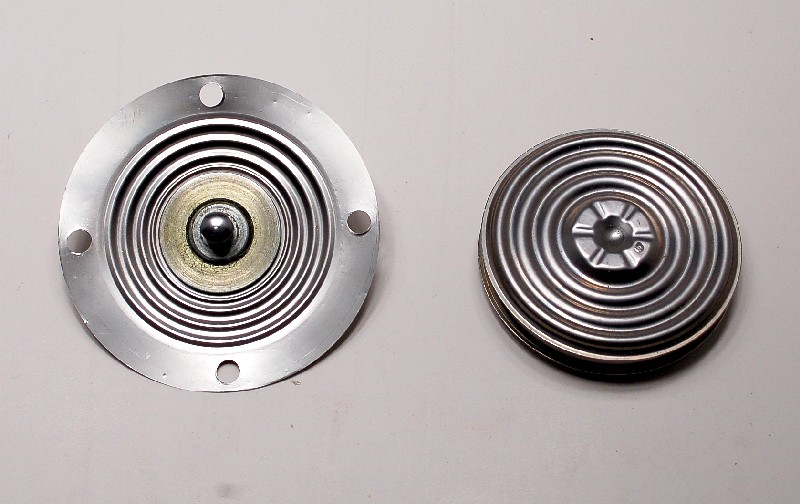 |
| detoxcowboy |
 Jan 30 2010, 11:19 PM Jan 30 2010, 11:19 PM
Post
#5
|
|
Senior Member    Group: Members Posts: 1,294 Joined: 30-January 08 Member No.: 8,642 Region Association: Africa |
"This came from a rebuilt MPS that was in a pond or river for some time. There was actually sand in it, along with tiny aquatic snail shells of some sort,"
THey just took it out and chucked it in the water (IMG:style_emoticons/default/blink.gif) NIce work, great research thanks for sharing.. |
| Dave_Darling |
 Jan 31 2010, 01:21 AM Jan 31 2010, 01:21 AM
Post
#6
|
|
914 Idiot           Group: Members Posts: 14,984 Joined: 9-January 03 From: Silicon Valley / Kailua-Kona Member No.: 121 Region Association: Northern California 
|
They gave it the "float test"? (IMG:style_emoticons/default/wink.gif)
(Must'a thought it was part of a single-Weber setup, perhaps...) --DD |
| 914Sixer |
 Jan 31 2010, 08:08 AM Jan 31 2010, 08:08 AM
Post
#7
|
|
914 Guru      Group: Members Posts: 8,882 Joined: 17-January 05 From: San Angelo Texas Member No.: 3,457 Region Association: Southwest Region 
|
Of the MPS I have taken apart, I have only seen version 4 in what looks like solid copper. I know where there are several VW Type 3 MPS that are NOS that I was considering buying them for just the diaphram. I might get one just to take it apart.
|
| pbanders |
 Feb 1 2010, 11:11 AM Feb 1 2010, 11:11 AM
Post
#8
|
|
Senior Member    Group: Members Posts: 939 Joined: 11-June 03 From: Phoenix, AZ Member No.: 805 |
Wow, really great info! With your permission and credit to you, can I use some of the photos and data on my MPS page (see link in sig)?
You mention the full-load diaphragm provides altitude compensation. This is only true under heavy and full-load conditions. The only MPS's that provided part-load altitude compensation were the 0 280 100 100 series that was used on the MB's. These units lacked the full-load diaphragm (full-load was sensed by the throttle switch) and had an altitude compensation cell that was connected to the atmosphere through a holow screw. I agree with your observation that the lower the "stiffness", or spring constant of the diaphragm, the less effect it will have on the transition characteristic. For any material used, the thickness and pleat design will vary. Reliability and resistance to fatigue failure is also an important consideration in the material selection. Crafting the aneroid cells out of a different material and/or a different pleat design would be tricky. The issue here is to identically duplicate the pressure vs. displacement characteristic of the OEM cells. It would interesting to compare the SS cells to the OEM cells for this characteristic. Positioning of the full-load stop is also critical to defining the transition region, setting the proper full-load mixture, and reducing the mechanical stress on the full-load diaphragm. Bosch sets most MPS to a 2 in. Hg engagement, though I have seen some units set to 4 in. Hg. Again, great stuff, thanks for sharing it with us. |
| mtndawg |
 Feb 1 2010, 04:31 PM Feb 1 2010, 04:31 PM
Post
#9
|
|
Member   Group: Members Posts: 414 Joined: 26-January 09 From: Granite Bay, Ca Member No.: 9,985 Region Association: None 
|
This information is great.This is what I've often wondered about...If another diaphragm were created, it would have to be made with consideration for temperature, thickness, flexibility, pleat design, etc...Basically all the things you've mentioned. Jim you are on the right track!
|
| jk76.914 |
 Feb 1 2010, 08:46 PM Feb 1 2010, 08:46 PM
Post
#10
|
|
Senior Member    Group: Members Posts: 809 Joined: 12-April 05 From: Massachusetts Member No.: 3,925 Region Association: North East States |
Wow, really great info! With your permission and credit to you, can I use some of the photos and data on my MPS page (see link in sig)? You mention the full-load diaphragm provides altitude compensation. This is only true under heavy and full-load conditions. The only MPS's that provided part-load altitude compensation were the 0 280 100 100 series that was used on the MB's. These units lacked the full-load diaphragm (full-load was sensed by the throttle switch) and had an altitude compensation cell that was connected to the atmosphere through a holow screw. I agree with your observation that the lower the "stiffness", or spring constant of the diaphragm, the less effect it will have on the transition characteristic. For any material used, the thickness and pleat design will vary. Reliability and resistance to fatigue failure is also an important consideration in the material selection. Crafting the aneroid cells out of a different material and/or a different pleat design would be tricky. The issue here is to identically duplicate the pressure vs. displacement characteristic of the OEM cells. It would interesting to compare the SS cells to the OEM cells for this characteristic. Positioning of the full-load stop is also critical to defining the transition region, setting the proper full-load mixture, and reducing the mechanical stress on the full-load diaphragm. Bosch sets most MPS to a 2 in. Hg engagement, though I have seen some units set to 4 in. Hg. Again, great stuff, thanks for sharing it with us. On the data and photos- you're welcome to them, with one caveat. We're using beryllium in a project at work, and one of the characteristics is that it is transparent to X-rays. So I need to verify that our XRF is capable of detecting Be in alloys. If not, those numbers may not be right. I'm travelling until the end of the week, so it'll be Friday before I can get with the lab guy. We have other means of measuring alloys that I can pursue that don't use X-Rays. The brass and stainless alloys should be correct.... Sorry to everyone if my info was premature. I'll be sure to confirm or correct it shortly. That makes sense about the full load only altitude compensation. The diaphram has to lift off the stop for any compensation to occur.... makes sense. I have a 0 280 100 120 MPS from a Cosworth Vega that is like the MB MPS you described... but then it is, as you said, part of the 100 series... Interesting that Chevrolet licensed the technology directly from Bendix, not Bosch, but all the comonents are Bosch. I measured several (maybe 6) aneroid cells sets using the same MPS, but with the diaphram locked. I set their inductance to a common value at the same vacuum, and then measured and plotted the curves. Their slopes are identical. I plotted them on the same axis, and they are as coincident as I can imagine. These 6 included a set from a 0 280 100 001 (early type 3, no diaphram, probably the simplest MPS out there) AND the stainless steel set. So now I'm setting up to measure the vacuum/L curves for diaphrams alone. I sacrificed a set of perfectly good aneroid cells by cutting them open and filling them with gorilla glue to set them. I let them harden in my vise with the jaws set to original cell dimension (gorilla glue expands when it hardens, and would have pushed them open). First thing I found was that the cells ARE MANUFACTURED WITH PARTIAL VACUUM INSIDE!! As soon as my cutoff blade broke through, they expanded out and became flacid. Anyway, now that they're hardened up, I'm going to measure inductance curves, which will represent the response of the diaphrams alone. I'm thinking that I can combine the diaphram and cell responses using superposition and get pretty close to what the finished MPS should be.... getting interesting. |
| pbanders |
 Feb 2 2010, 09:25 AM Feb 2 2010, 09:25 AM
Post
#11
|
|
Senior Member    Group: Members Posts: 939 Joined: 11-June 03 From: Phoenix, AZ Member No.: 805 |
I measured several (maybe 6) aneroid cells sets using the same MPS, but with the diaphram locked. I set their inductance to a common value at the same vacuum, and then measured and plotted the curves. Their slopes are identical. I plotted them on the same axis, and they are as coincident as I can imagine. These 6 included a set from a 0 280 100 001 (early type 3, no diaphram, probably the simplest MPS out there) AND the stainless steel set. That's good to know that replacements for the cells exist that accurately duplicate the OEM cells response to vacuum. QUOTE First thing I found was that the cells ARE MANUFACTURED WITH PARTIAL VACUUM INSIDE!! If you look at the Bosch MPS patent that's referenced at my site, they state that the cells are evacuated - i.e. under vacuum. I assume this was to eliminate issues with the reference pressure. |
| jk76.914 |
 Feb 9 2010, 05:49 AM Feb 9 2010, 05:49 AM
Post
#12
|
|
Senior Member    Group: Members Posts: 809 Joined: 12-April 05 From: Massachusetts Member No.: 3,925 Region Association: North East States |
I'm back. I looked in to this, and unfortunately, I was right (the second time). XRF cannot measure elements with atomic numbers lower than about 12, and Be is 4. XRF is steadily improving its detection technology, but given that Be is transparent to X-rays, it'll probably never be able to detect it.
How it works (roughly)- an X-ray is beamed onto the sample, which excites the electrons in the atoms, so they move to a higher energy level. When the X-ray is stopped, they move back to their original level, and emit photons (light), at a frequency that is characteristic of the element(s). So if a material is transparent to X-ray, it doesn't get excited. So I poked around at alternatives. EDX (or EDS) analysis is similar but uses a beam of electrons from a scanning electron microscope to add the energy instead of X-rays. Measurement is then similar. Looks like they can read down to atomic number 5- still not low enough for Be, but still a pretty simple test.... It may be enough to just detect presence of Be, if not the actual amount. That may be enough, since many BeCu alloys I've investigated only have maybe 3% Be, so just knowing its there may be enough to know what we'd be in for trying to reproduce it. Still checking... So anyway, I want to delete the table in my original post- anyone know how I can go in and edit that post? I'd probably replace it with one that at least still shows the stainless and brass composition... Sorry about the red herring, guys. |
| ArtechnikA |
 Feb 9 2010, 06:17 AM Feb 9 2010, 06:17 AM
Post
#13
|
|
rich herzog      Group: Members Posts: 7,390 Joined: 4-April 03 From: Salted Roads, PA Member No.: 513 Region Association: None |
...anyone know how I can go in and edit that post? when you (the OP) view the post you will see, at the bottom-right of the post, a small box with edit options. 'Full' is just like the original composition page, with smileys and formatting widgets and such. 'Quick' is a basic text editor if you're just changing words around. Make your changes and click 'Complete Edit.' Ta Da. |
| pbanders |
 Feb 9 2010, 08:57 AM Feb 9 2010, 08:57 AM
Post
#14
|
|
Senior Member    Group: Members Posts: 939 Joined: 11-June 03 From: Phoenix, AZ Member No.: 805 |
I used to do a lot of surface analysis when I worked in silicon microcontamination in the '80's and '90's. My guess is that there may be some simpler chemical tests you could use instead of surface analysis. I'll ask one of my old colleagues about this and see what he says.
|
| pbanders |
 Feb 9 2010, 09:53 AM Feb 9 2010, 09:53 AM
Post
#15
|
|
Senior Member    Group: Members Posts: 939 Joined: 11-June 03 From: Phoenix, AZ Member No.: 805 |
I used to do a lot of surface analysis when I worked in silicon microcontamination in the '80's and '90's. My guess is that there may be some simpler chemical tests you could use instead of surface analysis. I'll ask one of my old colleagues about this and see what he says. I haven't heard back yet, but I did some poking around on the web. I had a dim memory of this earlier that I wasn't sure of, but it tuned out to be correct. If you're going to use surface analysis, you need an Auger Electron Spectroscopy (AES - also known as as SAM scopes) tool, which is sensitive to light elements. |
| pbanders |
 Feb 9 2010, 10:02 AM Feb 9 2010, 10:02 AM
Post
#16
|
|
Senior Member    Group: Members Posts: 939 Joined: 11-June 03 From: Phoenix, AZ Member No.: 805 |
Also seems like once we get a material and a design together, we could get a custom metal shop to pump out a run of them. Example:
http://www.peterforg.com/metal-stamping-services.html Big issue I see with this diaphragm is getting the central threaded flange fabricated and pressed on. I assume this is a two-part assembly that's pressed into place. |
| Bleyseng |
 Feb 9 2010, 10:47 AM Feb 9 2010, 10:47 AM
Post
#17
|
|
Aircooled Baby!           Group: Members Posts: 13,034 Joined: 27-December 02 From: Seattle, Washington (for now) Member No.: 24 Region Association: Pacific Northwest |
From RustyWa years ago in a PM to me.
"You were correct....COPPER. -------- Ok, did the marterial analysis on the OEM diaphram this morning using a Niton XL-II 800 handheld alloy analyzer. I made three different scans of the sample piece I got from Geoff. The readings were as follows: #1 - 99.78% Cu #2 - 99.20% Cu #3 - 99.39% Cu No berillium. Supposedly anything between 98%-100% copper is considered pure. The remainder of the 100% reading was a spattering of Al, Si Br, Phos Brz." The stamping of the copper pleat isn't too hard to setup but as you say the two part center is. I looked at making a stamp with a machinist friend and it wasn't expensive. Coming up with the center part is and blocked my efforts. My tests on units with steel diaphrams were they aren't as responsive and tend to make the car jerky in real world driving. |
| pbanders |
 Feb 9 2010, 10:53 AM Feb 9 2010, 10:53 AM
Post
#18
|
|
Senior Member    Group: Members Posts: 939 Joined: 11-June 03 From: Phoenix, AZ Member No.: 805 |
From RustyWa years ago in a PM to me. "You were correct....COPPER. -------- Ok, did the marterial analysis on the OEM diaphram this morning using a Niton XL-II 800 handheld alloy analyzer. I made three different scans of the sample piece I got from Geoff. The readings were as follows: #1 - 99.78% Cu #2 - 99.20% Cu #3 - 99.39% Cu No berillium. Supposedly anything between 98%-100% copper is considered pure. The remainder of the 100% reading was a spattering of Al, Si Br, Phos Brz." The stamping of the copper pleat isn't too hard to setup but as you say the two part center is. I looked at making a stamp with a machinist friend and it wasn't expensive. Coming up with the center part is and blocked my efforts. My tests on units with steel diaphrams were they aren't as responsive and tend to make the car jerky in real world driving. Great info, thanks. Though it's pure Cu, CuBe might be better, as it has much better fatigue resistance. Might not be as flexible, though. I wonder if the 2-part flange stamping is a common part type? |
| Bleyseng |
 Feb 9 2010, 11:17 AM Feb 9 2010, 11:17 AM
Post
#19
|
|
Aircooled Baby!           Group: Members Posts: 13,034 Joined: 27-December 02 From: Seattle, Washington (for now) Member No.: 24 Region Association: Pacific Northwest |
From RustyWa years ago in a PM to me. "You were correct....COPPER. -------- Ok, did the marterial analysis on the OEM diaphram this morning using a Niton XL-II 800 handheld alloy analyzer. I made three different scans of the sample piece I got from Geoff. The readings were as follows: #1 - 99.78% Cu #2 - 99.20% Cu #3 - 99.39% Cu No berillium. Supposedly anything between 98%-100% copper is considered pure. The remainder of the 100% reading was a spattering of Al, Si Br, Phos Brz." The stamping of the copper pleat isn't too hard to setup but as you say the two part center is. I looked at making a stamp with a machinist friend and it wasn't expensive. Coming up with the center part is and blocked my efforts. My tests on units with steel diaphrams were they aren't as responsive and tend to make the car jerky in real world driving. Great info, thanks. Though it's pure Cu, CuBe might be better, as it has much better fatigue resistance. Might not be as flexible, though. I wonder if the 2-part flange stamping is a common part type? I can source Cu-Be sheet from a friend in The Netherlands in fairly small quantities if you want some. For this I would need the alloy percentages. I can't commit to do anything on MPS's myself now as I am leaving for Suriname for 6 mos next month. I do have a ton (50+) junk MPS's and parts laying around that I would love to have diaphrams for at some point. I'll take a diaphram with me to have a machinist make a stamp in Suriname (cheap). |
| JeffBowlsby |
 Feb 9 2010, 02:36 PM Feb 9 2010, 02:36 PM
Post
#20
|
|
914 Wiring Harnesses      Group: Members Posts: 8,501 Joined: 7-January 03 From: San Ramon CA Member No.: 104 Region Association: None 
|
As easy as it would be to make it from pure copper I have a hard time believing it is only coppper. Cu is such a soft metal and it work hardens very quickly.
This from the internet showing how little beryllium is sometimes used in its alloy form: "The most popular alloys of beryllium at the present time are those with copper metal. Copper-beryllium alloys contain about 2 percent beryllium. They conduct heat and electricity almost as well as pure copper but are stronger, harder, and more resistant to fatigue (wearing out) and corrosion (rusting). These alloys are used in circuit boards, radar, computers, home appliances, aerospace applications, automatic systems in factories, automobiles, aircraft landing systems, oil and gas drilling equipment, and heavy machinery. and... Health effects Beryllium is a very toxic metal. It is especially dangerous in powder form. The effects of inhaling beryllium powder can be acute or chronic. Acute effects are those that occur very quickly as the result of large exposures. Chronic effects are those that occur over very long periods of time as the result of much smaller exposures. Acute effects of inhaling beryllium powder include pneumonia-like symptoms that can result in death in a short time. Chronic effects include diseases of the respiratory system (throat and lungs), such as bronchitis and lung cancer. Read more: http://www.chemistryexplained.com/elements...0f4XtvMtO" I also looked into have the two piece center fitting fabbed at one time. I found the press-fit clamping ring at McMaster Carr, its a stock item. The inner-threaded fixture should not be hard at all for a machist with a lathe, and its may be possible to simply cut off the clamping washer from existing diaphrams with a dremel and reuse them with a new clamping ring - have not tried it though. The two-piece fixture would need to be pressed together, presumably on an arbor press. And this which shows that some mfrs make BeCu with as little as .15% Be by weight. Attached image(s) 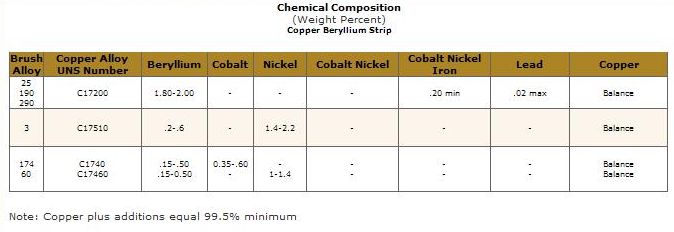
|
  |
1 User(s) are reading this topic (1 Guests and 0 Anonymous Users)
0 Members:

|
Lo-Fi Version | Time is now: 13th May 2024 - 11:10 AM |
Invision Power Board
v9.1.4 © 2024 IPS, Inc.









